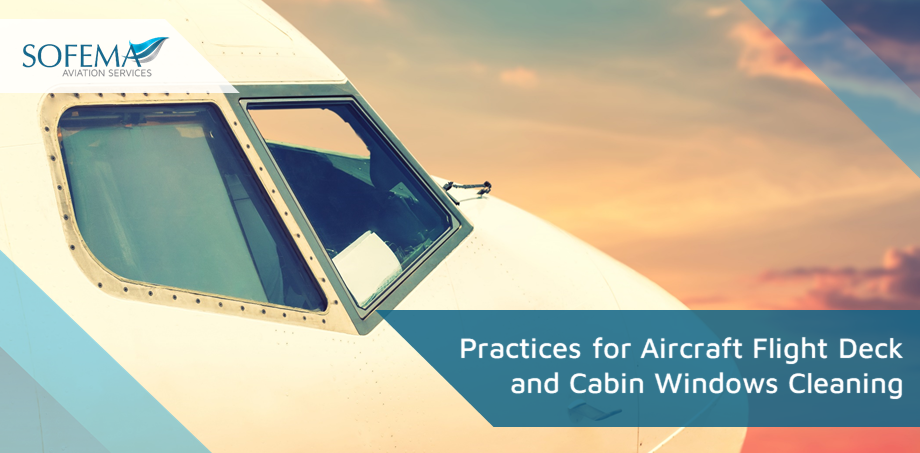Sofema Aviation Services (SAS) www.sassofia.com considers best practices and techniques to ensure the correct maintenance of Aircraft Flight Deck and Cabin Windows.
Introduction
Aircraft windows, both in the flight deck and the cabin, are critical components that ensure visibility, safety, and comfort for the crew and passengers. Proper maintenance and cleaning are essential to ensure their longevity and performance.
Regularly inspect windows for any signs of damage, such as cracks, scratches, or discolouration. Early detection of these issues can prevent more significant problems down the line.
Flight Deck – Cockpit Windows Construction
Cockpit windows are designed to provide maximum visibility while minimizing distortion, they are also shaped and angled to reduce aerodynamic drag and to deflect potential bird strikes.
Aircraft cockpit windows are typically made from high-strength materials that can withstand the stresses of flight, including rapid changes in pressure and temperature, as well as impacts from birds or other debris.
Note – Always follow the aircraft manufacturer’s guidelines and recommendations when cleaning and maintaining flight deck windows.
Common Flight Deck Window Materials Include
- Polycarbonate: A type of plastic known for its impact resistance and optical clarity.
- Laminated Glass: Multiple layers of glass bonded together with interlayers, which can prevent shattering upon impact.
- Stretched Acrylic: Used in many military and commercial aircraft for its strength and clarity.
Cockpit windows often consist of multiple layers, each serving a specific purpose:
- Outer Layer: Designed to withstand impacts and aerodynamic forces.
- Heated Layer: Most cockpit windows have embedded electrical heating elements to prevent ice formation and remove frost or condensation.
- Inner Layer: Provides additional protection and often has anti-reflective or other coatings.
Routine Cleaning
- Use a soft cloth or sponge.
- Use mild detergent and water. Avoid using ammonia-based cleaners as they can damage some window materials.
- Always clean in a gentle, circular motion to avoid scratching.
Removing Bugs and Debris
- Soak the area with a cleaning solution to soften the debris.
- Gently wipe away. Avoid scraping or using abrasive materials.
Scratch Removal
- Minor scratches can sometimes be polished out using specialized compounds.
- Deep scratches or cracks may require window replacement.
Important Notes & Safety Precautions
- Never use solvents or harsh chemicals that can degrade the window material or seals.
- Avoid cleaning in direct sunlight, as some cleaning agents can react adversely when heated.
Cleaning Aircraft Cabin Windows
The aircraft windows are normally made of plastic and can be easily damaged during the cleaning process. It is therefore highly recommended that brushes and abrasive clothes shall not be used for such type of cleaning.
The correct way of aircraft window cleaning is to use clean, soft, lint-free cloths that are specially designed and approved for aircraft or sensitive environment glass or transparent plastic cleaning. Along with the approved and recommended cleaning products, the aircraft window cleaning is carried out using the aircraft manufacturer’s procedures outlined especially for window cleaning.
Note – Always follow the aircraft manufacturer’s guidelines and recommendations when cleaning and maintaining cabin windows.
Cleaning Techniques
- Dry Cleaning: Use a soft, lint-free cloth or microfiber towel to gently wipe away loose dust and debris. Always wipe in a straight, linear motion rather than in a circular pattern to avoid scratching.
- Wet Cleaning: If the window is very dirty or has stubborn spots, use a clean cloth dampened with a mild, approved detergent solution. Wipe the window gently, then follow up with a dry cloth to remove any residue.
Cleaning Products
- Always use cleaning products that are approved for aircraft windows.
– Many general-purpose cleaners can damage the special coatings or the material of the windows.
- Check the aircraft’s maintenance manual or consult the window manufacturer for a list of approved cleaners.
Important Notes
- Avoid Ammonia-Based Cleaners – These can damage the window’s protective coatings and lead to premature ageing.
- Avoid Abrasives – Never use abrasive pads, brushes, or cleaning agents, as they can scratch and damage the window.
Next Steps
Follow this link to our Library to find & download related documents for Free.
Please see the following training course: Aircraft Servicing, Cleaning, and Detailing – 2 Days. For questions or comments please email team@sassofia.com
Tags:
Aircraft, EASA, Maintenance, Airworthiness, SAS blogs, SAS training, Aircraft Cleaning, Aircraft General Cleaning, Aircraft Flight Deck, Cabin Windows Maintenance, Cabin Windows Cleaning





